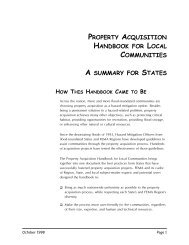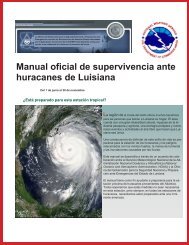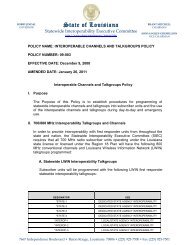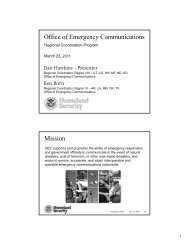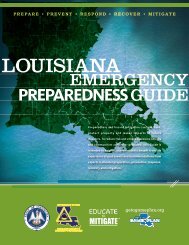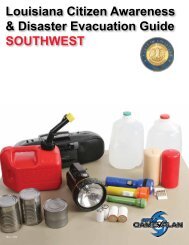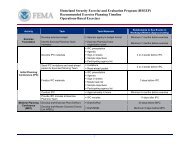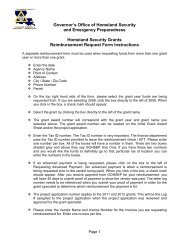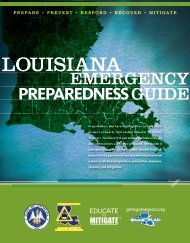Before the Federal Communications Commission Washington, D.C. ...
Before the Federal Communications Commission Washington, D.C. ...
Before the Federal Communications Commission Washington, D.C. ...
- No tags were found...
You also want an ePaper? Increase the reach of your titles
YUMPU automatically turns print PDFs into web optimized ePapers that Google loves.
<strong>Federal</strong> <strong>Communications</strong> <strong>Commission</strong> FCC 02-64asserts that <strong>the</strong> proposed change will not compromise <strong>the</strong> ability of existing consumer wea<strong>the</strong>r radios toreceive EAS alerts.53. We will amend Part 11 to require that <strong>the</strong> modulation level of EAS codes be at <strong>the</strong>maximum possible level, but in no case less than 50% of full channel modulation limits. Thisamendment will bring <strong>the</strong> Part 11 rules into alignment with <strong>the</strong> actual modulation levels currentlyobtainable by broadcasters. Because this amendment simply conforms <strong>the</strong> Part 11 rules with currentpractice, we are satisfied that it will not reduce <strong>the</strong> ability of consumer wea<strong>the</strong>r radios to receive EASalerts.E. Protocol for Text Transmission54. In <strong>the</strong> NPRM, we invited comment on SBE’s request that we amend <strong>the</strong> Part 11 rules toinclude a specific protocol for text transmission. 119 According to SBE, a protocol for text transmissionwould enable broadcasters and cable operators to make greater use of already formatted text messages inorder to provide more detailed disaster information and updates. SBE suggested that text informationcould be transmitted immediately following <strong>the</strong> existing EAS message format, using <strong>the</strong> existing AudioFrequency Shift Keying (“AFSK”) technique. We noted, however, that we had no information or data tosupport <strong>the</strong> addition of text messaging to <strong>the</strong> EAS system using <strong>the</strong> AFSK technique or any o<strong>the</strong>r schemeand that we were aware of no comprehensive field tests that have been conducted to show <strong>the</strong> viability ofdifferent text formats. As an alternative to SBE’s suggestion, we sought comment on whe<strong>the</strong>r we shouldadd a local event code (TXT) that can be used as an indicator that textual information will be transmittedafter <strong>the</strong> End of Message code. We observed that this alternative would allow for <strong>the</strong> testing of differenttextual formats and could eventually lead to an industry standard.55. We will not adopt a specific EAS text transmission protocol at this time. The generalconsensus among <strong>the</strong> commenters is that fur<strong>the</strong>r study and evaluation of text transmission techniques andadditional data on <strong>the</strong> cost and feasibility of adding text processing to existing EAS equipment areneeded before <strong>the</strong> <strong>Commission</strong> can adopt a text transmission protocol. 120 Even SBE now advocatesadditional study of <strong>the</strong> matter with <strong>the</strong> goal of creating a widely supported technical standard. 121 Weagree that fur<strong>the</strong>r study and field testing of text transmission methodologies is needed before a specifictext protocol can be adopted. Fur<strong>the</strong>rmore, we believe that <strong>the</strong> costs and feasibility of upgrading existingEAS equipment to add text messaging capability must be carefully evaluated. We note that <strong>the</strong>re ispresently no information in <strong>the</strong> record on which to base such an evaluation. In addition, we share <strong>the</strong>concern raised by NCTA that <strong>the</strong> adoption of a text protocol may require modification of <strong>the</strong> standarddeveloped by <strong>the</strong> cable industry for digital EAS alerts. 122 Accordingly, we will not take action on thismatter herein. We encourage <strong>the</strong> broadcast and cable industries to work with state and local EASauthorities, <strong>the</strong> hearing impaired community and o<strong>the</strong>r interested parties to evaluate different texttransmission techniques and develop an industry standard for EAS text transmission.119NPRM, 16 FCC Rcd at 7263.120NAB Comments at 3-4; Named StBAs Comments at 14; WSAB/WA SECC Comments at 13; NCTAComments at 9; Cox Comments at 5; NWS Comments at 8; RadioShack Comments at 6; Thunder Eagle Commentsat 14-15; Named StBAs Reply Comments at 7.121122SBE Comments at 5; SBE Reply Comments at 7.NCTA Comments at 9.22




